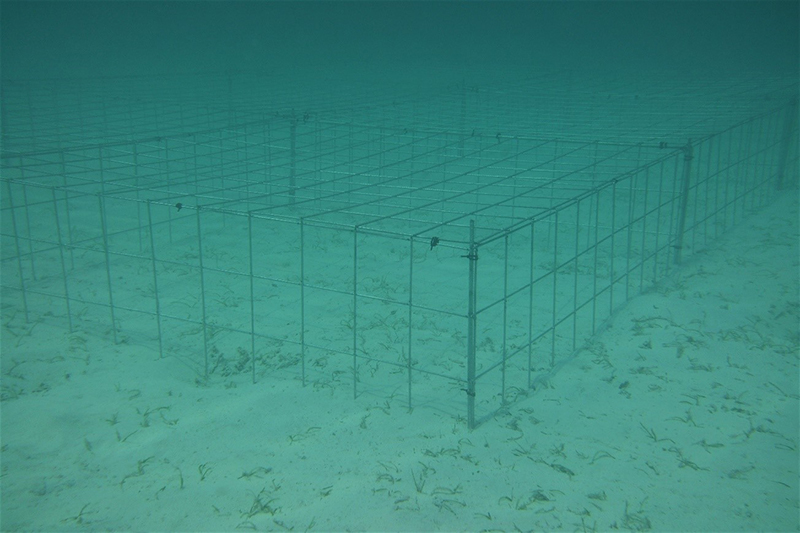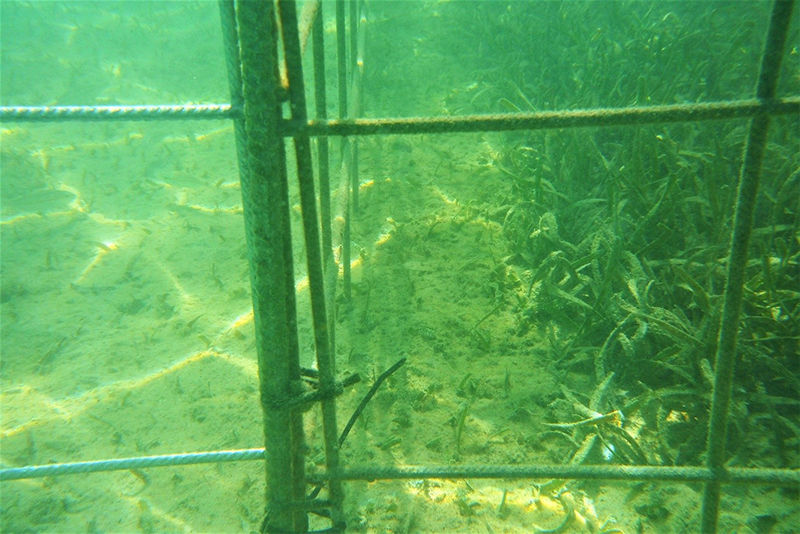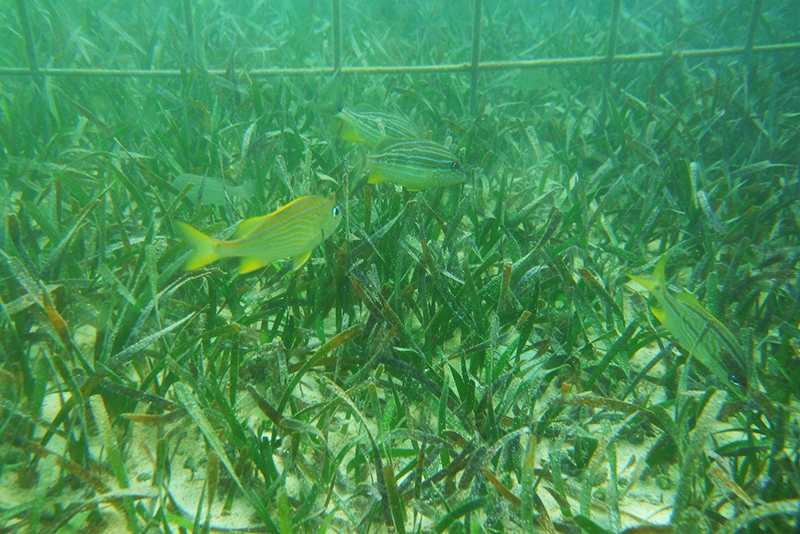Seagrass Restoration Project Donors Thanked
The Minister of Home Affairs Walter Roban and the Department of Environment and Natural Resources [DENR] have extended their thanks for the “generous donations received from the public to assist with the seagrass restoration project.”
A Government spokesperson said, “DENR initiated a seagrass restoration project in June 2020 which involves placing large mesh restoration cages over seagrass areas struggling to survive.
Seagrass restoration cage deployed at Chub Heads in August 2020
Minister Roban explained, “Anyone swimming or boating around our Island last summer is likely to have noticed that many of our seagrass meadows have disappeared for example at Admiralty Park and Somerset Long Bay.
“In a few places where the seagrass is short, it no longer provides refuge for juvenile fish, newly settled spiny lobsters and other small animals. This loss of seagrass will very likely upset the dynamics of our shallow water environment as well as negatively impact recreational and commercial fisheries.”
Minister Roban added, “On behalf of the Ministry, I wish to extend our sincere gratitude to the generous donors who have contributed to this project. With these recent donations, DENR can expand the seagrass restoration project beyond the six areas currently caged.
Turtle grazing along the inside edge of the seagrass restoration cage
“The additional material will enable the restoration of larger areas of seagrass at more locations, both inshore and offshore. The Department is extremely grateful to members of the public who are committed to creating areas of restored seagrass in Bermuda which in turn benefits a host of marine organisms and ecosystems.”
“The most visible cages are the ones at Bailey’s Bay and Trunk Island. The public can see a cage from the shore in Flatt’s Inlet located by the seawall adjacent to the Bermuda Aquarium Museum and Zoo.”
“Bermuda’s seagrass decline is due in part to shoreline development, dredging, ocean dumping and land creation, installation of concrete and floating docks, physical damage from boat propellers, anchoring, boat groundings and moorings.
“All have impacted our inshore seagrass meadows over the years. At Bermuda’s northern latitude [32°N] the cooler water temperatures and shorter day lengths in winter limit seagrass growth rates and their ability to recover from any negative impact.
Successful seagrass restoration at Trunk Island
“More recently, green turtle grazing has put unprecedented pressure on these habitats leading to their local collapse. The plants struggle to recover from the intensive grazing by the increasing number of juvenile green turtles arriving on the Bermuda Platform. This increase in green turtles is most likely due to conservation successes at nesting beaches to our south.
“Once the seagrasses under the restoration cages have long healthy blades they will provide habitat for juvenile fish, young lobsters and other critters, such as seahorses and juvenile queen conch that have all lost their habitat with the loss of seagrass.
“Green turtles will be able to eat the seagrass around the inside edges of the cages, and once the seagrass blades are long enough, from the top of the cage, while still leaving enough seagrass to provide shelter for other organisms.
“The presence of seagrass meadows increases the amounts and kinds of food that are available for wildlife. Seagrasses are the basis of a complex food web and are essential for food security to many animals, including humans.”
Read More About
Category: All, Environment, News






Here in the UK, at Studland, Dorset, on the south coast we have exactly the same problem….shallow calm waters with extensive sea grass beds that flourish in the shelter of a headland, and one time home to a colony of spiny sea horses is a perfect place to set anchor. On a sunny weekend there can be a couple of hundred boats anchored over the sea grass beds, enjoying the calm anchorage. The anchors and chains disturb the sea horses and denude the sea grass…you just can’t avoid it. There are so many boats anchoring there now that a recent survey failed to find a single sea horse. The colony has disapeared. Areas of seagrass can be cordoned off using markers but it has to be policed. The Bermudian cages strike me as a great idea!!
Seems like nobody is talking about the over prevalence of turtles. They have almost single handily decimated Bermuda’s sea grass. It would be good if we had some hard data on Bermuda’s turtle population and their impact on our sea grass.
Its great to have a minister with genuine passion for Bermuda’s environment. Thanks Minister Roban!
At least the turtles will devour jellies, which will make swimmers happy.